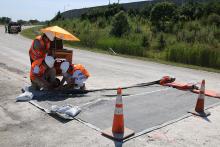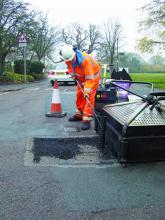Optimism about the future of highways worldwide abounded at the inaugural European Road Infrastructure Conference (ERIC) in Leeds, UK. Around 500 delegates passed through the varied sessions during the three-day event at the Royal Armouries Museum in the northern English city of Leeds. They came away with many visions of what a motorway and road could look like. But what speakers at the event - co-organised by the Brussels-based European Union Road Federation (ERF) and the UK’s Road Safety Markings Associat
Optimism about the future of highways worldwide abounded at the inaugural European Road Infrastructure Conference (ERIC) in Leeds, UK
Around 500 delegates passed through the varied sessions during the three-day event at the Royal Armouries Museum in the northern English city of Leeds. They came away with many visions of what a motorway and road could look like.
But what speakers at the event - co-organised by the Brussels-based European Union Road Federation (ERF) and the UK’s Road Safety Markings Association – couldn’t give was a definitive vision.
That was hardly surprising. Many speakers acknowledged that the so-called “smart road” is evolving at lightening pace because of the application of information communication technologies. There appears no end to what is possible, from sensors buried into road surfaces and road tunnel linings to highway signs that change their message based on what they “observe”.
It is a continuum of development, said Adewole Adesiyun, deputy secretary general of the Forum of European National Highway Research Laboratories (FEHRL). “The innovation is there,” he said in his presentation. “We just need the courage to implement it.”
Increasingly, highway authorities must respond to users’ needs and not what traditionally has been regarded as a lowest-cost strip of bitumen. Users want more from a road and designers must make the road adaptable to accepting new technologies. It must also be resilient towards its physical environment to maintain an acceptable driving standard. This could be anything from self-healing bitumen to a self-cleaning surface. Many institutional research projects in Europe are underway, such those by the France-based DVDC – Durée de vie Chaussées/Pavement Life Cycle – group. The private sector is also exploring innovation, such as the SustIMS asset management solution from Portuguese highways operator Ascendi.
SustIMS is a single data management system to coordinate the main elements of any road infrastructure to optimise resources, explained Carlos Neves, head of monitoring and maintenance of bridges at Ascendi. SustIMS not only integrates historic and real-time information, but also predicts future performance of each element, recommending the best maintenance and rehabilitation strategies.
Asphalt quality
Asphalt producers are having to work harder than ever to satisfy more stringent pavement requires as demanded by local and national governments, said Carsten Karcher, European Asphalt Pavement Association (EAPA). These demands are often a result of environmental issues and not simply the fact that more and more traffic is piling onto roads. Companies are having to produce higher quality asphalt to cope with these demands to ensure a pavement lasts longer.
This makes whole-life costing of roads all the more important, said Karl Downey, secretary general of EUPAVE, the Brussels-based European Concrete Paving Association. This is more often practiced in North America than Europe. The Canadian province of Ontario has introduced what they call “alternative bids” when it goes out to tender. Companies are asked to submit two bids. One is based on a more prescriptive design. The other is based on user-benefits and whole-life costing. The choice is open for the province.
Many discussions about future highways too often focus solely on motorways. There should be more emphasis on a country’s national roads. After all, these are the last links in the economic and social benefits chain, said Christophe Nicodème, director general of the ERF. National roads should get more funding than is the case now, he told delegates, because 72% of freight movements in Europe are on national roads.
During a session focussing on asset management, delegates heard about innovative technologies for boosting the effective life of pavements. One such product and system is that of the TriAx geogrid from Tensar, a ground stabilisation technology company based in the UK. Tim Oliver, Tensar’s vice president of global products and application management, explained that the tensile stiffness of biaxial geogrids, which lays between the base and upper asphalt surfaces, is predominantly in two directions.
He explained that with the TriAx geogrid the tensile stiffness is now multi-directional. Aggregates “interlock” within the three-dimensional deep-rib triangles to ensure especially strong adhesion layer of the upper and lower layers.
Delegates heard how the University of Leeds is pushing the boundaries of drone and robotic maintenance for road infrastructure, including lighting. Robert Richardson is director of the Institute of Engineering Systems and Design, as well as being head of the university’s National Facility for Innovative Robotic Systems. His goal is to have Leeds be the world’s first city to be maintained by robots.
The facility is researching what it calls "perceive and patch" technology whereby drones inspect, diagnose and repair potholes in roads. Similarly, "perch and repair"
systems will have drones that can perch,
like birds, high up on street lights to make simple repairs, such as changing lights.
There is also "fire and forget" systems for utility pipes. Robots that are permanently installed in sections of a pipe can be called upon anytime to perform inspections, make repairs and take meter readings for volumes and flows.
Self-healing asphalt through induction heating is a possibility, explained Alvaro Garcia Hernandez, a lecturer at the University of Nottingham. The bitumen mix includes fibres that will conduct enough energy when heated to boost the viscosity of the bitumen so it will flow into cracks faster and be a more effective process than simply adding a patch or injecting hot bitumen. Nottingham’s labs are researching the type of particles as well as the intensities and frequencies of induction heating which are most appropriate for healing.
What of the future?
Will future highways be smarter than the vehicles travelling down them, asked Nicolas Hautiere, a deputy director at the French Institute of Science and Technology for Transport (IFSTTAR).
He foresees roadside signs being replaced by virtual signs that amount to sensors along the road. Similarly, sensors in a car travelling down the highway will pick up information being emitted by the roadside sensor. This information in turn will be displayed on the vehicle’s interior visual display unit (VDU).
Dynamic vehicle charging systems embedded in some roads are already being tested at a French traffic research centre in Satory, near Versailles, a city close to Paris.
Research is happening into solar panels embedded into the road surface to take advantage of the fact a road is often bathed in light for many hours for days on end. Also, there is some research into taking heat from a road – a highway is a natural heat sink – and using it to heat nearby homes and business.
But it remains to be seen how driverless vehicles will affect the physical aspects of the smart highway, said Hautiere.
Ben Immers, a consultant in Traffic management, agreed that the physical roadsign is looking more and more like an endangered species. Smart road signs will only be smart if they observe their environment and turn that information into readable guidance for drivers and driverless vehicles. Smart signs will “observe, interpret, decide and act” based on the information they receive.
At the moment, signs interpret for vehicle drivers who are the majority road users. What about the future when there is a greater mix of transportation methods, such as buses, pedestrians, cyclists, motorcyclist, electric vehicles and small buggy drivers? And how many of these will be driverless as well?
Around 500 delegates passed through the varied sessions during the three-day event at the Royal Armouries Museum in the northern English city of Leeds. They came away with many visions of what a motorway and road could look like.
But what speakers at the event - co-organised by the Brussels-based European Union Road Federation (ERF) and the UK’s Road Safety Markings Association – couldn’t give was a definitive vision.
That was hardly surprising. Many speakers acknowledged that the so-called “smart road” is evolving at lightening pace because of the application of information communication technologies. There appears no end to what is possible, from sensors buried into road surfaces and road tunnel linings to highway signs that change their message based on what they “observe”.
It is a continuum of development, said Adewole Adesiyun, deputy secretary general of the Forum of European National Highway Research Laboratories (FEHRL). “The innovation is there,” he said in his presentation. “We just need the courage to implement it.”
Increasingly, highway authorities must respond to users’ needs and not what traditionally has been regarded as a lowest-cost strip of bitumen. Users want more from a road and designers must make the road adaptable to accepting new technologies. It must also be resilient towards its physical environment to maintain an acceptable driving standard. This could be anything from self-healing bitumen to a self-cleaning surface. Many institutional research projects in Europe are underway, such those by the France-based DVDC – Durée de vie Chaussées/Pavement Life Cycle – group. The private sector is also exploring innovation, such as the SustIMS asset management solution from Portuguese highways operator Ascendi.
SustIMS is a single data management system to coordinate the main elements of any road infrastructure to optimise resources, explained Carlos Neves, head of monitoring and maintenance of bridges at Ascendi. SustIMS not only integrates historic and real-time information, but also predicts future performance of each element, recommending the best maintenance and rehabilitation strategies.
Asphalt quality
Asphalt producers are having to work harder than ever to satisfy more stringent pavement requires as demanded by local and national governments, said Carsten Karcher, European Asphalt Pavement Association (EAPA). These demands are often a result of environmental issues and not simply the fact that more and more traffic is piling onto roads. Companies are having to produce higher quality asphalt to cope with these demands to ensure a pavement lasts longer.
This makes whole-life costing of roads all the more important, said Karl Downey, secretary general of EUPAVE, the Brussels-based European Concrete Paving Association. This is more often practiced in North America than Europe. The Canadian province of Ontario has introduced what they call “alternative bids” when it goes out to tender. Companies are asked to submit two bids. One is based on a more prescriptive design. The other is based on user-benefits and whole-life costing. The choice is open for the province.
Many discussions about future highways too often focus solely on motorways. There should be more emphasis on a country’s national roads. After all, these are the last links in the economic and social benefits chain, said Christophe Nicodème, director general of the ERF. National roads should get more funding than is the case now, he told delegates, because 72% of freight movements in Europe are on national roads.
During a session focussing on asset management, delegates heard about innovative technologies for boosting the effective life of pavements. One such product and system is that of the TriAx geogrid from Tensar, a ground stabilisation technology company based in the UK. Tim Oliver, Tensar’s vice president of global products and application management, explained that the tensile stiffness of biaxial geogrids, which lays between the base and upper asphalt surfaces, is predominantly in two directions.
He explained that with the TriAx geogrid the tensile stiffness is now multi-directional. Aggregates “interlock” within the three-dimensional deep-rib triangles to ensure especially strong adhesion layer of the upper and lower layers.
Delegates heard how the University of Leeds is pushing the boundaries of drone and robotic maintenance for road infrastructure, including lighting. Robert Richardson is director of the Institute of Engineering Systems and Design, as well as being head of the university’s National Facility for Innovative Robotic Systems. His goal is to have Leeds be the world’s first city to be maintained by robots.
The facility is researching what it calls "perceive and patch" technology whereby drones inspect, diagnose and repair potholes in roads. Similarly, "perch and repair"
systems will have drones that can perch,
like birds, high up on street lights to make simple repairs, such as changing lights.
There is also "fire and forget" systems for utility pipes. Robots that are permanently installed in sections of a pipe can be called upon anytime to perform inspections, make repairs and take meter readings for volumes and flows.
Self-healing asphalt through induction heating is a possibility, explained Alvaro Garcia Hernandez, a lecturer at the University of Nottingham. The bitumen mix includes fibres that will conduct enough energy when heated to boost the viscosity of the bitumen so it will flow into cracks faster and be a more effective process than simply adding a patch or injecting hot bitumen. Nottingham’s labs are researching the type of particles as well as the intensities and frequencies of induction heating which are most appropriate for healing.
What of the future?
Will future highways be smarter than the vehicles travelling down them, asked Nicolas Hautiere, a deputy director at the French Institute of Science and Technology for Transport (IFSTTAR).
He foresees roadside signs being replaced by virtual signs that amount to sensors along the road. Similarly, sensors in a car travelling down the highway will pick up information being emitted by the roadside sensor. This information in turn will be displayed on the vehicle’s interior visual display unit (VDU).
Dynamic vehicle charging systems embedded in some roads are already being tested at a French traffic research centre in Satory, near Versailles, a city close to Paris.
Research is happening into solar panels embedded into the road surface to take advantage of the fact a road is often bathed in light for many hours for days on end. Also, there is some research into taking heat from a road – a highway is a natural heat sink – and using it to heat nearby homes and business.
But it remains to be seen how driverless vehicles will affect the physical aspects of the smart highway, said Hautiere.
Ben Immers, a consultant in Traffic management, agreed that the physical roadsign is looking more and more like an endangered species. Smart road signs will only be smart if they observe their environment and turn that information into readable guidance for drivers and driverless vehicles. Smart signs will “observe, interpret, decide and act” based on the information they receive.
At the moment, signs interpret for vehicle drivers who are the majority road users. What about the future when there is a greater mix of transportation methods, such as buses, pedestrians, cyclists, motorcyclist, electric vehicles and small buggy drivers? And how many of these will be driverless as well?








